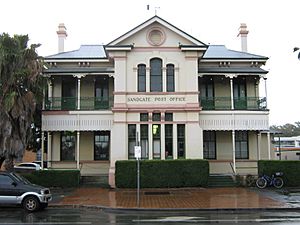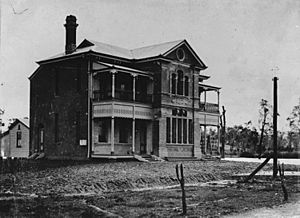Sandgate Post Office facts for kids
Quick facts for kids Sandgate Post Office |
|
|---|---|

Sandgate Post Office, 2008
|
|
| Location | 1 Bowser Parade, Sandgate, City of Brisbane, Queensland, Australia |
| Design period | 1870s - 1890s (late 19th century) |
| Built | 1886 - 1887 |
| Architect | Office of the Queensland Colonial Architect |
| Official name: Sandgate Post Office, Sandgate Post, Telegraph Office | |
| Type | state heritage (built) |
| Designated | 7 February 2005 |
| Reference no. | 600290 |
| Significant period | 1886-1887, c. 1907 (fabric) 1886-c. 2004 (historical) |
| Significant components | post & telegraph office, residential accommodation - post master's house/quarters |
| Lua error in Module:Location_map at line 420: attempt to index field 'wikibase' (a nil value). | |
The Sandgate Post Office is a very old and important building in Sandgate, Australia. It used to be a post office where people sent letters and telegrams. It was built a long time ago, between 1886 and 1887. The building was designed by the office of the Queensland Colonial Architect. Today, it is listed on the Queensland Heritage Register because it's a special part of history.
Contents
A Look Back in Time: The History of Sandgate Post Office
The Sandgate Post Office is a two-story building. It was built in 1886 and 1887. Before this building, Sandgate had a post office since 1864. That first office was on Eagle Terrace.
Why a New Post Office?
In the early 1880s, a new spot was bought for the post office. This new location was closer to the railway line. The railway had just arrived in Sandgate in 1882. This made the area more important.
In 1885, the government wanted plans for a new post office. They wanted it to cost no more than £2,000. The first designs were too expensive. So, new plans were made.
Who Designed and Built It?
The final design was overseen by George St Paul Connolly. He was Queensland's first architect born and trained in Australia. A local builder named William Street won the contract. He built the post office for £2,025. The bricks for the building likely came from a local brickworks.
The new post office was quite large for a suburban area. This showed that the government believed Sandgate was growing. Sandgate was a popular seaside resort. It was also becoming a place where people lived and traveled to work in Brisbane by train. Sandgate even had its own local government back then. It didn't become a "suburb" of Brisbane until 1925.
Opening and Changes Over Time
The Sandgate Post Office opened on May 7, 1887. The postmaster lived on the second floor. The ground floor had the post and telegraph offices. There was also a public area. A separate building held the kitchen and servant's rooms.
The outside of the building was originally a light color. It has been painted since 1894. The way the public area was set up became a common design for other post offices. This building was one of only three large, two-story brick post offices built in Brisbane.
A telephone service started at the post office in 1898. A telephone exchange was added in 1907. This exchange moved to a new building around 1959. After World War II, the upstairs verandahs were closed in. From 1981, the top floor was used for offices.
The outside of the building was fixed up in 1983-1984. The inside was also made new for the building's 100th birthday. The building was a post office until about 2004. Then, it was sold to a private business.
What It Is Now
For some years, the building was a restaurant called 4017 Bar and Grill. The name "4017" comes from Sandgate's postcode. By 2014, it had new owners. It was renamed the Chandelier Bar & Restaurant.
What Does It Look Like?
The old Sandgate Post Office is a two-story building. It is made of painted brick. It has an Italian Renaissance style. The roof is made of corrugated iron.
Front and Verandahs
The front of the building has a large, pointed section called a gabled portico. The words "Sandgate Post Office" are carved below the second-floor windows. Originally, it said "VR 1887." "VR" stood for Victoria Regina, meaning Queen Victoria. The building was built when she was queen.
There are verandahs on both sides of the front portico. They have wooden posts and fancy metal railings. These details were carefully remade in the 1983-1984 restoration. The verandah at the back of the building is still enclosed.
Inside and Other Buildings
The inside of the building has been changed and updated over the years. There is a separate wooden building at the back. This used to be the service wing, but it has been changed a lot.
There are also two newer brick buildings at the back. One was added around 1907 for the telephone exchange. The other is a newer building that was a postal depot. It was built in the 1980s. Both of these newer buildings match the style of the main post office.
The former Sandgate Post Office stands out on its corner. It is near the Sandgate war memorial and the old Sandgate Town Hall. It is an important part of the area's history.
Why Is It Important?
The Sandgate Post Office is listed on the Queensland Heritage Register. This means it is a very important historical site.
Showing History
This building helps us understand Queensland's history. It shows how much the government believed in the growing economy in the 1880s. It also shows how popular Sandgate was as a resort and a place to live. The building reminds us how important post and telegraph services were back then.
A Special Type of Building
The Sandgate Post Office is a great example of a late 19th-century post and telegraph office. It's a large, two-story brick building. It still looks much like it did when it was built. It shows the typical features of these buildings:
- Two stories tall.
- Made of brick.
- The postmaster lived upstairs.
- The offices were downstairs, with a big public area.
- It has classic design elements.
Beautiful and Important to the Town
The building is also important because it looks good and stands out in Sandgate. It's in the middle of the main shopping area. It's part of a group of historic buildings. These include the war memorial and the old town hall.
Creative Design
The design of this post office was very clever. It set a new standard for how post and telegraph offices were laid out in Queensland. This shows a high level of creative achievement for its time.


